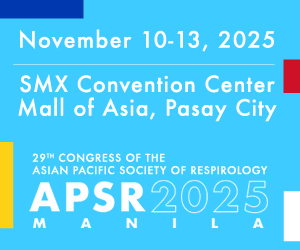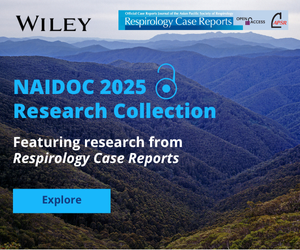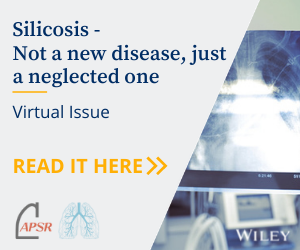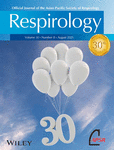Journal list menu
Export Citations
Download PDFs
ISSUE INFORMATION
CASE SERIES
Acute hypercapnic respiratory failure in patients with obesity hypoventilation syndrome during the COVID-19 pandemic: Four case reports
- First Published: 20 April 2023

The current coronavirus disease-2019 (COVID-19) pandemic has greatly impacted society and individual lifestyles. Recently, we encountered four patients with obesity hypoventilation syndrome (OHS) who developed acute hypercapnic respiratory failure (AHRF) during the COVID-19 pandemic. It is suggested that increased rates of obesity due to lifestyle changes during the COVID-19 pandemic may be responsible for an increase in the prevalence of OHS-associated AHRF.
CASE REPORTS
Prolonged response to first-generation tyrosine kinase inhibitor in a metastatic non-small cell lung cancer harbouring complex G719X and S768I mutations: A case report from Vietnam and literature review
- First Published: 29 March 2023

In this study, we report a patient with metastatic non-small cell lung cancer carrying rare EGFR compound mutations of G719X and S768I who benefited from first-line treatment with gefitinib in Vietnam. This patient had a prolonged response lasting over 44 months with first-generation TKI. He continued to take gefitinib without experiencing serious adverse events.
Malignant neoplasm of lacrimal gland with pulmonary metastasis
- First Published: 16 April 2023

A 65-year-old male diagnosed with a right lacrimal gland ACC T2N0M0 (surgically resected 12 years prior) presented with an incidentally noted 1.2 cm right lower lobe lung nodule seen on MRI liver. Subsequent imaging confirmed a non-FDG avid 1.6 cm solitary ovoid subpleural lesion, percutaneous biopsy confirmed adenocarcinoma. A surgical metastasectomy was performed and recovery was complete. Prognosis in ACC is improved with radical management of the metastatic disease. Rather than a simple chest radiograph, more detailed imaging, such as MRI or CT scanning may increase the probability of early detection of pulmonary metastasis and, thereby facilitate radical treatment and improve survival.
Krukenberg tumour as the initial manifestation of lung adenocarcinoma
- First Published: 04 April 2023
A case of bunashimeji mushroom-induced hypersensitivity pneumonitis diagnosed by inhalational provocation test in a hospital room
- First Published: 04 April 2023

Hypersensitivity pneumonitis (HP) is an immunological disorder related to repeated inhalation of sensitizing allergens. Only a small number of reports have described HP caused by mushrooms. Here, we report a case of bunashimeji mushroom-induced HP, diagnosed by environmental provocation test and inhalational provocation test in a hospital room.
Cardiovascular autonomic dysfunction induced by mechanical insufflation-exsufflation in Guillain–Barré syndrome
- First Published: 13 April 2023

We herein describe two cases of Guillain–Barré syndrome with cardiovascular autonomic dysfunction during MI-E. While Guillain–Barré syndrome itself may cause cardiac autonomic dysfunction, MI-E possibly caused or enhanced the autonomic dysfunction by an alternation of thoracic cavity pressure. The possibility of MI-E-related cardiovascular complications should be recognized, and its appropriate monitoring and management are necessary, particularly when used for Guillain–Barré syndrome patients.
An 83-year-old patient with RET fusion-positive non-small cell lung cancer experiencing severe hepatic disorder due to selpercatinib administration
- First Published: 09 April 2023
A case of resected pulmonary capillary hemangioma with a literature review
- First Published: 11 April 2023

We report a 63-year-old man who was diagnosed with a pulmonary capillary hemangioma with a literature review. On chest CT, the lesion was shown to be a solid nodule with contrast-enhanced margins. This finding was thought to reflect the dense vascular hyperplasia of the central part of the tumour based on the pathologic findings.
Severe COVID-19 pneumonia in pregnant woman treated with pulse corticosteroids therapy and third-trimester caesarean section: A case report
- First Published: 05 April 2023

In this case report, we present a critical COVID-19 case of a 44-year-old woman at 30 weeks of pregnancy. Her treatment was based on pulse corticosteroid therapy, accompanied by caesarean delivery. After nearly 1 month of hospitalization, with most of the time being in the intensive care unit, she was discharge and showed full recovery upon re-examination 10 months later.
A rare case of hemophagocytic lymphohistiocytosis mimicking flare of systemic lupus erythematosus
- First Published: 11 April 2023

Disseminated histoplasmosis can cause multiorgan involvement especially in a patient with underlying autoimmune disease as in this case of a 24-year-old female with HLH who was initially treated as a flare of autoimmune disease but later etiology was confirmed as disseminated histoplasmosis on bone marrow histopathological examination.
Rapidly progressive respiratory failure due to antisynthetase syndrome related interstitial lung disease
- First Published: 12 April 2023
The benefit of indwelling pleural catheter with ambulatory pneumothorax device and autologous blood patch pleurodesis in lymphangioleiomyomatosis with persistent air leak
- First Published: 12 April 2023

Lymphangioleiomyomatosis (LAM) is a rare cystic lung disease with the progressive formation of numerous small cysts. The course of the disease is complicated by recurrent pneumothoraces. This occurs due to cyst rupture into the pleural space or through alveolar wall disruption resulting in an air leak. Chemical or surgical pleurodesis is performed to prevent a recurrence. Persistent air leak (PAL) can complicate this condition. We report the successful use of IPC with an ambulatory pneumothorax device in a patient with LAM with PAL.
Targeted alveo-pleural fistula endobronchial valve treatment using ventilation scintigraphy
- First Published: 18 April 2023

Persistent air-leaks can be difficult to localize in radiology. Bronchoscopic management of air-leaks requires identification of the leak's location to allow suitable targeted treatment. One-way endobronchial valves have become a suitable option for persistent air-leaks. In this report, a combination scintigraphy and one-way endobronchial valve treatment successfully resolved a persistent air-leak.
Tezepelumab treatment for allergic bronchopulmonary aspergillosis
- First Published: 17 April 2023

The patient with allergic bronchopulmonary aspergillosis (ABPA) underwent treatment with tezepelumab; the mucus plugs and pulmonary opacities diminished gradually parallel to the improvement in the control of asthmatic symptoms. Tezepelumab might provide a novel steroid-sparing strategy for the management of ABPA.
Adenoid cystic carcinoma of the trachea mimicking asthma
- First Published: 20 April 2023
Lambert-Eaton myasthenic syndrome with primary thymic marginal zone B-cell lymphoma: A case report
- First Published: 18 April 2023

Lambert-Eaton myasthenic syndrome (LEMS) is a condition in which antibodies are produced against voltage-gated calcium channels in presynaptic nerve endings, resulting in an inability to release acetylcholine. It is characterized by fatigue and weakness of the proximal muscles of the extremities and is complicated by ocular symptoms, autonomic symptoms, and cerebellar ataxia. We report the case of a patient in whom comprehensive care with multiple departments successfully improved LEMS symptoms with primary thymic marginal zone B-cell lymphoma.
Adenocarcinoma with mediastinal lymph node involvement developed from a pure ground grass nodule during 14 years
- First Published: 25 April 2023
CLINICAL IMAGES
Transbronchial needle aspiration in severe cardiac failure patient: ‘The old bull knows best’
- First Published: 13 April 2023
Severe heart failure due to peripartum cardiomyopathy
- First Published: 09 April 2023

Perinatal cardiomyopathy develops during pregnancy or postpartum in women with no history of cardiac disease, presenting similarly to dilated cardiomyopathy. The pathogenesis is unknown but may be associated with both vascular damage and a genetic component. Physicians should consider pulmonary oedema due to perinatal cardiomyopathy in perinatal women with dyspnoea.
Physiologic 18F-FDG muscle uptake in severe COPD: Implications for accurate lung cancer staging
- First Published: 18 April 2023

18F-FDG accumulates in pathologic lesions, and minimal 18F-FDG may be observed in healthy muscles. However, physiologic 18F-FDG uptake is seen in patients with COPD due to excessive metabolic activity as presented in our patient in this case. Clinicians should be aware of this phenomenon and exercise caution when staging lung cancer in these patients to avoid misdiagnosis and unnecessary interventions.


















